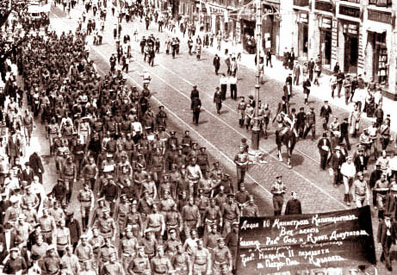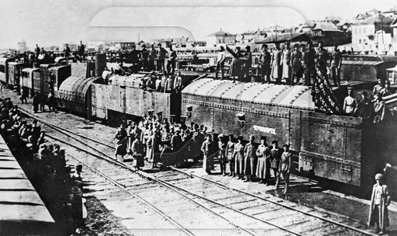 |
Peoples' movements and protests |
 |
|
MobilizationsFrench RevolutionThe Russian revolutionThe Revolutions of 1917-19IMF uprisingsLatin American wars of independenceNorth American war of independenceSlave uprising in HaitiIrish nationalism and Sinn FéinRussian revolutionIndia independence movementChinese revolutionAlgerian war of independencePalestinian movementVietnam warBreton movementBasque movementNorwegian opposition to EUBack to National movementsBack to Labour movementsBack to Bread seizuresBack to Old movementsBack to main page |
The Russian Revolution
Despite the fact that Russia was a military power from the 18th century, it was still a capital-poor periphery. Most of the industry was owned by foreign corporations and the political regime was of the most traditional kind. It was mainly the educated
urban middle class that strived for ”development” to
center country status, not least because of the greater freedoms
and development opportunities such one would bring to them personally.
But they realized that they themselves were too few to achieve anything.
They therefore sought to ally themselves with other classes. Two
middle-class parties each sought their allies. The socalled Bolsheviks invested in an alliance with the industrial workers in the foreign-owned industry, by e.g. defending workers affected by employer or state repression. They had greater success. The Russian state collapsed under the pressure of the First World War; the authoritarian regime did not cope with all the new tasks that forced itself on them and was too jealous of its privileges to release more competent people. It therefore lost the trust of all and sundry, and when communications stopped working and neither raw materials nor food reached the big cities and their industries while the soldiers deserted in the hundreds of thousands, many social groups began to look for an alternative regime that could help the situation. The triggering event was when soldiers refused to attack a workers’ demonstration for bread in March 1917. The regime fell because no one wanted to defend it, but it was more difficult to create a new one because the difficulties were the same for the crowds of politicians and military who tried. The soldiers, most of which were conscripted peasants, went home to seize the land of the landowners once and for all. And the workers occupied the factories to secure their jobs and wages. In that situation, the Bolsheviks were the only party, ie the only group with political ambitions, that accepted the situation, recognized the right of the peasants to the land and the right of the workers to the factories, and received support from them in return. In November 1917, the Bolsheviks were able to carry out an almost completely bloodless coup with the help of the Petersburg workers’ militia, against a government that no one defended anymore. The Bolsheviks could not solve the supply problems either. But they did not have to. For in that situation groups of soldiers tried to seize power with foreign support. Against this the Bolsheviks could successfully appeal to all patriotic forces in the country. This freed them from dependence on the workers. Which was lucky for them, because the civil war destroyed the industry that remained. The working class ceased to exist.
The national development policy pursued by the Bolsheviks from 1929 was desperate. The country’s resources were mobilized with terrorist methods in order to resist new attacks from outside. In the short term, the result was that the technical cadre enthusiastically joined the policy pursued, thanks to the new career opportunities created by the development policy. In the longer term, the result was increasing isolation for the ruling class and increasing difficulties for it to mobilize for its policies, as well as a brutalization of all relations in society. During the global downturn of 1973, Russia was one of the countries where the policy of national development first lost its credibility and where it collapsed most dramatically. Reading
|

